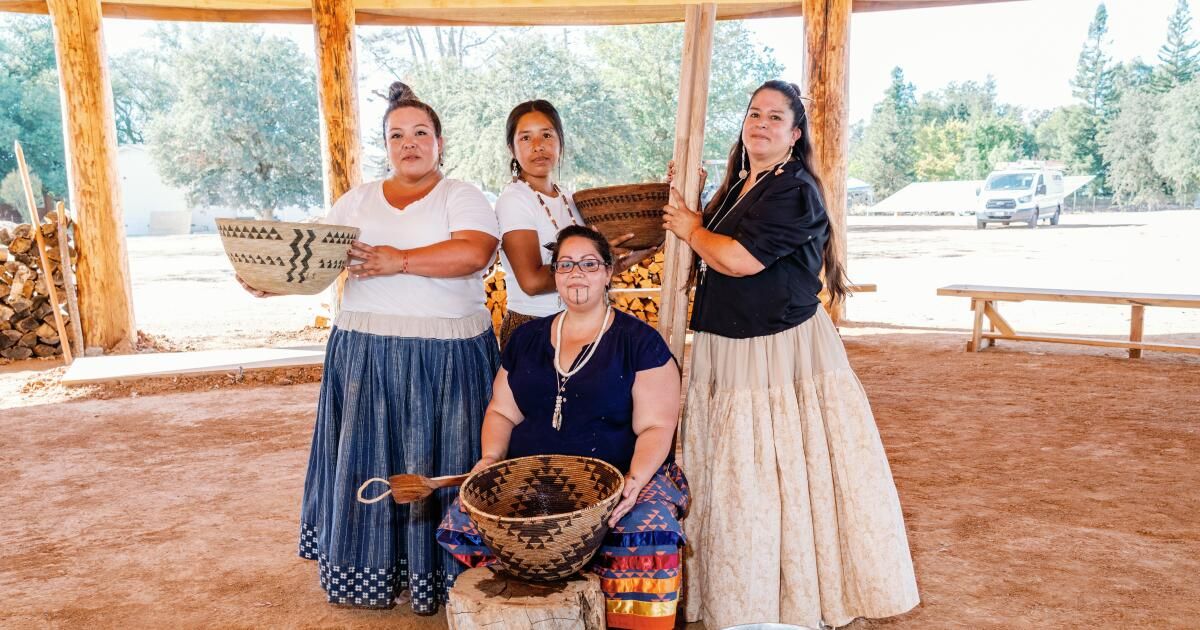Wilton, California – On a tempered day last week to the south of Sacramento, a group of women turned to grind and prepare acorn flour, and then used stones heated by fire to cook it with water in woven houses. It was a slow and sweaty process compared to the way they prepare meals at home. They did it to pay tribute to how their ancestors cooked and maintained over the centuries.
But these women, members of Wilton Rancheria, did not look back, were looking forward. This weekend, Sacramento will organize an important international meeting affiliated with the “Slow food” movement, and to the surprise of some, Wilton Rancheria is the main sponsor of the Americas Terra Mother of three days. The event is expected to attract approximately 100,000 people for culinary demonstrations, panels on sustainable agriculture and food policy, live music and, of course, delicious food.
The ranchería, whose members are descendants of the Miwok and Nisenan tribes in northern California, have recently been building wealth of their local casino, and tribal members have been using that to raise their stature and show their cultural heritage. The $ 500,000 that the tribe is contributing to Terra Mother, they say, is directed more towards the latter, including the demonstration of health and environmental benefits of traditional food practices.
“The natives are the original slow food people, right?” Said Jesús Tarango, president of Wilton Rancheria, who has more than 1,000 members. “My people have tried to live in balance and with a constant relationship with the earth … Terra mother, for me, talk to my people.”
California is home to 109 tribal nations recognized by the federal government, some small and fighters, others with successful game operations and growing ambitions. Wilton Rancheria Sky River Casino is located on highway 99, south of Sacramento. Last year, it became the first tribe in North America to assume the majority property of a male professional sports operation: the Sacramento Republic FC football team.
But leading the sponsorship of Terra Madre Americas is something new for this tribe of California. Every two years in Turin, Italy, Slow Food International has Terra Madre Salon del Taste, the world's largest food conference and the catalyst for a movement that advocates that food is “good, clean and righteous.” Last year, Sacramento took the opportunity to organize an American version of the event, a coup d'etat for the state capital, which will organize it every two years during the next decade.
Tarango sees it as a great opportunity for California tribes to share their experiences in a global scenario, while learning from the hundreds of indigenous delegates who are expected to visit from Latin America and other places.
“The most exciting thing is to be able to connect with other people with related ideas,” said Tarango, who previously helped manage an important Fedex center before becoming tribal president. “People who do the things we are doing but only in a different country, perhaps in a different way, maybe with different foods.”
The members of Wilton Rancheria prepare acorn soup – “Nupa” – inside an outdoor cenator south of Sacramento on September 17.
(Andri also / for times)
Before California was resolved by Europeans and others, the Miwok and Nisen Substed in a hunting-gatherer diet of acorns, deer, salmon, pine nuts, savings and other berries and plants. Some of Miwok food preparation gardens can be seen in Indian Grinding Rock State Rock, approximately one hour east of Sacramento, which has more than 1,000 mother rock mortars, the largest collection of its kind in North America.

The old mortar holes, used to grind acorns, can be seen in the historical park of the Rock Rock Indio state, located in the foothills of Sierra Nevada, about 57 miles east of Sacramento.
(Carol M. Highsmith / Buyenlarge through Getty Images)
The settlers and later the United States government suppressed and ruthlessly exterminated the miwok and other tribes. In the twentieth century, Tarango's ancestors worked to recover some of their lands. But they were stolen again when Congress approved the Rancheria Law of 1958, which rescinded the obligations of trust of the Earth to dozens of California tribes. (Rancheria is a Spanish term for a small tribal town).
Finally, in 2009, the Wilton ranchería recovered federal recognition, which allowed the tribe 15 years later to assume control of a 77 acres package in Wilton, not far from the Cosumnes River. There, the tribe has built a center for the elderly and a shaded cenator for its ceremonial meetings, including the creation of “Nupa”, the word Miwok for acorn soup.
Traditionally, only the women of the tribe make “Nupa”, although men help build the fire and wear huge sacks of acorns. Last week, several of these women demonstrated the process. As some rocks heated in the fire and others crazy and used stones to grind the acorns in the flour, the smell of burning oak trunks permeated the air.

The members of Wilton Rancheria gathered acorns without crack in a fabric basket and used a stone to hit and break their hard exterior shells, during a demonstration of traditional acorn soup in the outdoor cenador of the tribe.
(Andri also / for times)
Raquel Williams, the vice president of the ranchería, sat on the floor, grinding acorn meat in a stone mortar that had been transmitted by his great -grandmother. The art of making Nupa survive today because Miwok and Nisenan were made sure that each child was taught this type of ancient customs.
Williams were asked about what he thought while the acorns were grinding.
“You always have to think with your heart first,” she replied. “If your heart takes first place, that permeates your body, and falls into your arms, and goes to your hands. So all that power and all that love travels to your fingers, and crosses these rocks.”
While Williams was Molando, his mother, Daveen Williams, lifted rocks of the fire with a couple of long wooden posts.
“These rocks are like microwave,” he said, immersing them quickly in water cubes to eliminate ash.

Amanda Geisdorff circulates the hot basalt rock in a traditional basket for cooking acorn soup during a demonstration of traditional cooking methods.
(Andri also / for times)
Then, the rocks were placed in a woven basket with water and acorn flour that had rinsed and align again for several days, to eliminate bitter tannins. A tribe friend, Amanda Geisdorff, used a tool to quickly turn the rocks in the basket, making sure that the basket did not burn and that none of the boiling liquids spilled on it.
The soup, slightly sweet and comforting, was ready in just a few minutes. Daveen Williams said he was satisfied with the result.
“It is a pride among us women to make sure that not making Nupa have a bitter taste or having ashes,” said Williams, who prepares the soup during the ceremonies several times a year.
The manufacture of the acorn soup will be presented at the Terra Mother Americas event, and the three -day program also includes panels on sustainable agriculture, impacts of climate change in wine and beer and meals prepared by famous chefs such as the Jeremiah tower, Mary Sue Milliken and Sean Sherman, an author of books of books of Oglala Lakota Sioux and owners of restaurants restaurants owners. Alice Waters, from the fame of Chez Panisse, is one of the speakers, along with UC Davis food experts, Latin America, Italy and other parts of the world.
By coincidence, Terra Madre is launched on the same day, on Friday, that the California tribes have their 58th annual day of the Native Americans of California, a mixture of networks, shared activities and cultural activities, in the State Capitol.
As the preparations accelerated this year for Terra Madre, Sacramento's organizers became cautious that President Trump's immigration repression could discourage some foreign visitors to attend. Those fears have been confirmed since then.

GEISDORFF Levante a little acorn flour during the demonstration of the manufacture of soup in the outdoor cenor of Wilton Rancheria.
(Andri also / for times)
Last week, Sacramento Abradged's news site reported that some Latin American farmers and chefs had decided to stay at home, although they initially wanted to be part of the event.
“I think there has been some fear,” said Mike Testa, president and executive director of Visit Sacramento, in an interview. “What finally means to be seen.”
The possible setback occurs after Sacramento spent several years laying the foundations for Terra Mother.
With the help of Waters, the Restorer of Testa and Sacramento, Patrick Mulvaney, built a relationship with Paolo Di Croce, general director of Slow Food International. They and others traveled to Italy to further develop the ties of the city with the organization. According to Testa, Sacramento was able to get an agreement with slow food before other cities were aware of the opportunity.
Testa, after connecting with UC Davis and his network of food specialists, then contacted Wilton Rancheria, who did not hesitate, he said, by accepting sponsoring the event.
“We tend to think a little out of the box when it comes to situations or opportunities,” said Tarango, who also persuaded the Band of Indians of the Pala mission and the association of presidents of the tribals of southern California. To contribute. “When Terra Madre appeared, we wanted to jump on board.”
Surrounded by cultivation lands, Sacramento is at the confluence of the American and Sacramento rivers, and as a result, “Confluence” is a main theme of this year's inaugural meeting. Tarango expects a broader conversation about how indigenous people can join to influence American agriculture and healthier diets.
“We are trying to find the intersection that we are between traditional food forms and modern health solutions,” he said. “We are trying to unite things.”












